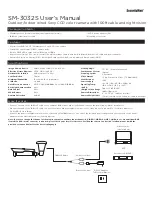
Chapter 7
Leica R-Lenses
2
__Zoomrange
The choice of focal lengths is very practical. Many years
ago Canon has analysed thousands of photographs and
concluded that the most often used apertures and speeds
are 1:8 and 1/125 and that the most used focal lengths
were within the 28 mm and 90 mm range. If we believe
these studies, the new Leica lens would cover the most
used range of focal lengths with one zoom movement.
This Leica lens is a fine addition to the expanding range of
Vario-lenses, but it cannot be a jack of all trades.
A macro facility is not available, but can be found in the
companion lens Vario-Elmar-R 35-70 mm f/4 . And for most
applications, the near focus limit of 0.6 meter on the 90
mm position may suffice. The aperture range from 1:2.8 to
1:4.5 has enough speed for current high quality medium
speed films. One would have hoped for a slightly wider
aperture at the telephoto side of the zoomrange. But that
wish would have clashed with the desire for a compact lens.
Remember that the famous Vario-Elmarit-R 35-70 mm f/2.8
had a front diameter of 88 mm and extrapolating this to the
90 mm position, one would have to live with a lens with a
diameter in the neighbourhood of 120 mm and a much hig-
her weight due to the proportionally heavier glass lenses.
The aperture ring has numbers from 2.8 to 22 and one
should be aware that this range only holds for the focal
lengths from 28 to35 mm.
The 50 mm aperture starts at 3.4 and the 90 mm at 4.5.
If you are at the 90 mm position, the aperture setting of 2.8
corresponds to 4,5 and the 22 is in fact 36.
One should be careful when using a handheld meter or
when one uses the A-setting and wants to select a specific
aperture. It is easiest to use the aperture indication in the
finder.
__ LEICA VARIO-ELMARIT-R 28-90 MM F/2.8-4.5 ASPH




























